Porcelain Insulator News
By Elton Gish
Reprinted from "Crown Jewels of the Wire", March 2007, page 24
I thought we covered this type of insulator in a past PIN, but now discover
it has been overlooked. There has been some interest recently in the old
"submarine" insulator. Many years ago someone used that term and the
guess seemed logical as a possible use for this most unusual insulator; namely,
for carrying electrical cables in the cramped space aboard a submarine. The
usual form of the insulator is rather large measuring twenty-three inches long
and eight inches wide at the base.
There is one other style that I have seen. It is nicknamed the Harp. A
retiree from the Locke Baltimore plant had it. He said it was made in the early
1940's during WWII.
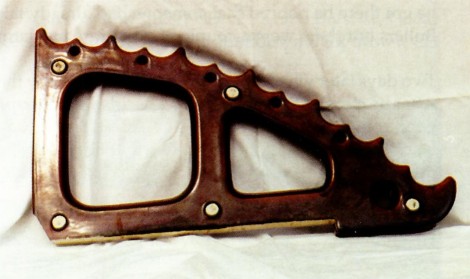
This harp-shaped insulator was made
by Locke in the early 1940's.
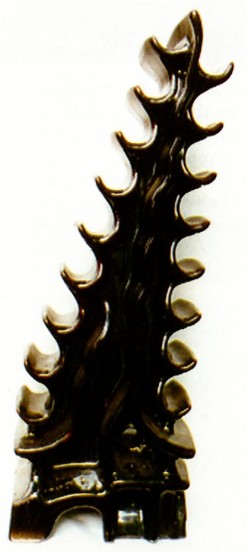
"Submarine"
This odd looking, heavy
porcelain insulator has 17 grooves.
Six years ago Dan Howard sent me copies of a few pages from the December 1925
issue of Proceedings of the Institute of Radio Engineers. There were several
photos of the so-called "submarine" insulator used in a large antenna
tuning coil. The insulator is referred to as a spacing block. A few of the
photos from the article are shown here. I've also seen an Ohio Brass catalog
from the 1920's that showed tuning coils that used the large 23-inch spacing block insulator. The
photos were nearly identical to some of those shown here. Most likely these early spacing block insulators were made by Ohio Brass.
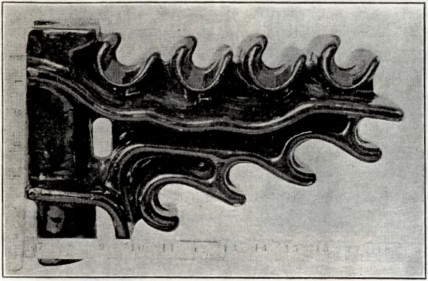
(Figure 2) Porcelain Spacing Block for
the Conduction of Antenna Tuning Coil
Outdoor antenna tuning coils were very large. Small 18-inch long spacing
block insulators (Figure 2) were bolted and clamped to a vertical framework made
of porcelain rods (Figure 3) that were mounted on a concrete base. Indoor tuning
coils were more compact and had the spacing block insulators with 17 grooves
(Figure 11) set around a 36-inch diameter porcelain cylinder. The one in the
Figure 10 shows five spacing block insulators around the
porcelain cylinder, which makes up one section. The
insulators were not bolted
to the porcelain cylinder but simply held against it firmly by the 17 heavy
cables wrapped around in the grooves of the insulator. Up to six of these
completed sections were then stacked depending on the voltage, nearness to large metal objects, etc.
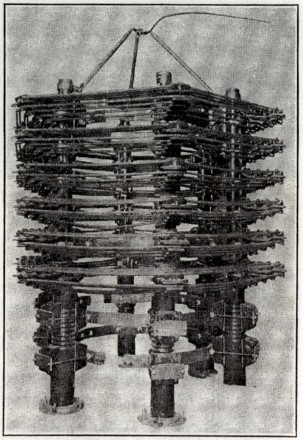
(Figure 3) Tuning Coil for
United Fruit Company,
Radio Equipment
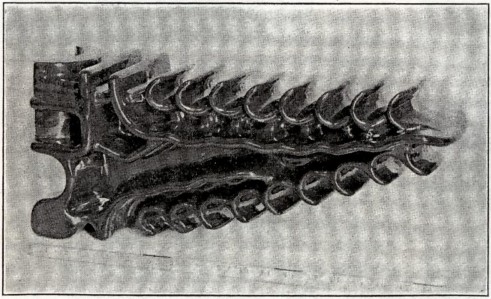
(Figure 11) Porcelain Spacing Block with
Seventeen Grooves, for Unit Type
High Power
Antenna Tuning Coil
Apparently the larger 17-groove spacing block insulators were more popular
since a number of them have been obtained by collectors.
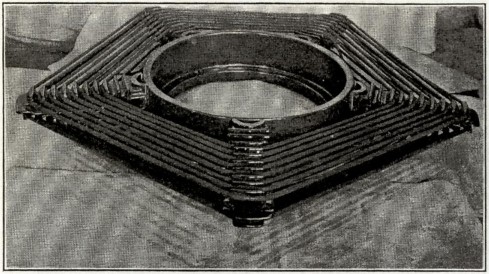
One Section of Unit Type High Power
Antenna Tuning Coil
Another odd insulator was reported by Steve Corfidi. Chris and Marilyn Hedges
visited with Steve and his wife on their way to the National last year. Chris
noticed a white-glazed Locke wireholder in Steve's collection that I got in
April 1984 from the electrical construction division of Sparrows Point
(Baltimore), MD facility of Bethlehem Steel Corporation. Chris suspected that
the porcelain unit might be threaded, and he was indeed correct.
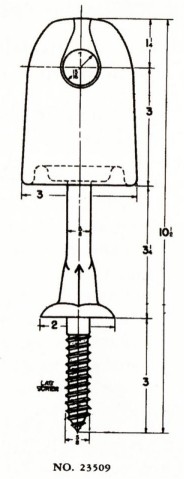
U-339C in the 1941 Locke Catalog
The same wireholder was used to a limited extent by Baltimore Gas and
Electric Co. on series street light circuits and on low voltage vertical runs
along poles at test transformer locations. All of the B. G. & E. wireholders;
however, were brown-glazed and cemented to their pins. Steve sent me a scan of
Locke 23509 from their 1941 catalog, which is identical to Steve's insulator.
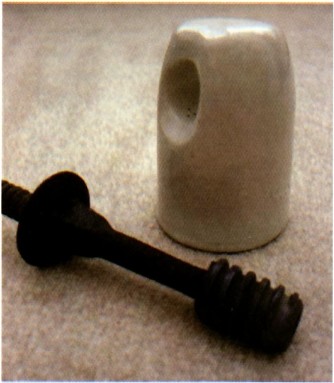
U-339C
(4-1/4 x 3)
The white pin-type insulator was finally removed from its pin with the aid of
a strong vise. Steve said there were other white Locke 23509's in the bin at
Bethlehem Steel, but the company has since gone bankrupt and he did not know
what happened to the bin of electrical materials. So, only one of these
insulator has survived. The insulator is similar to other slack wire pin-type
insulators: the Pittsburg U-339 and the Fred Locke U-339A and U-339B. Steve's
insulator has been assigned U-339C.
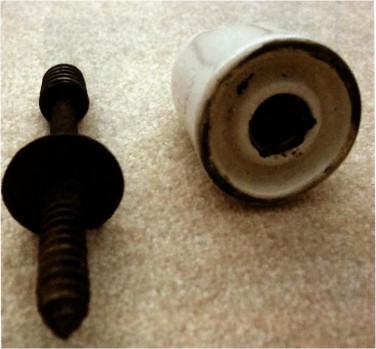
Bottom of Locke U-339C
The dimensions of U-339C are identical to those in the catalog drawing. The
pin seems to be of the ordinary screw-type, although the threads are somewhat
more squarely cut than most Steve has seen, and the threaded shank is a bit
shorter (1-1/2 , inches long vs. 1-5/8 inches). The pin has a single capital
"S" embossed on the top (unknown marking).
George Pek sent in this large 6-inch diameter, metal, photo button of a
telegrapher. He is wearing head phones with pencil in hand, sitting at a desk
with telephone and telegraph key. You can see a white porcelain insulator near
the center of the photo above the shelves on desk. George said the majority of
these buttons are usually ordinary portraits of unknown people with blank
stares, but this one is particularly interesting. The photo button from circa
1912 is stamped on the back, "Columbia Medallion Studios, Chicago" .
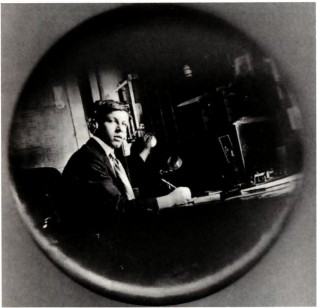
Six-inch photo button
of a young telegrapher
Trivia: This may come as a shock for Wisconsinites, but the kiln men in 1898
in Trenton, NJ carried pottery balanced on their heads in round porcelain boxes
called saggers. This earned them the original nickname of "cheeseheads."
The round saggers were stacked in beehive kilns and fired for about 50 hours to
convert the clay insulators into vitrified porcelain.
| 